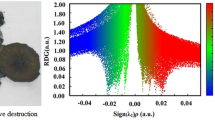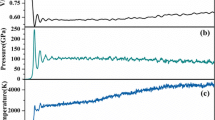Abstract
Density functional theory BLYP/DNP and hyperhomodesmotic equations were employed to calculate ring strain energy, the bond dissociation energy of X–NO2 (X=C, N) and the charges on the nitro groups of several four-membered and six-membered heterocycle compounds. BLYP/DNP and LST/QST + CG method were also applied to calculate bond rotational energy of X–NO2 (X=C, N) of above mentioned compounds. It indicated that ring strain energy of four-membered heterocycle nitro compounds is apparently higher than that of six-membered heterocycle nitro compounds. Predictably, ring-opening reactions may preferentially occur for those compounds containing higher ring strain energy under shock. In addition, C–NO2 bonds in these compounds may rotate easier than N–NO2 bonds in response to the external shock. As for N–NO2 bonds in these compounds, they also respond to the external shock by the rotation of N–NO2 bonds, once to the saddle point of the rotational energy barrier, the whole molecule will become relaxed, N–NO2 bond becomes weaker and eventually leads to the breakage. When one −C=O, −C=NH or −NH2 group is introduced to the six-membered heterocycle, the charges on the nitro groups of the new compound decrease drastically, and ring strains increase remarkably. It can be predicted that the new compounds will be more sensitive to shock, and the viewpoint is confirmed by the experimental results of shock sensitivity (small scale gap test) of several explosives.

Similar content being viewed by others
References
Kuklja MM (2003) Appl Phys A 76:359–366
Tokmakoff A, Fayer MD, Dlott DD (1993) J Phys Chem 97:1901–1913
Dlott DD (2000) Acc Chem Res 33:37–45
McNesby KL, Coffey CS (1997) J Phys Chem B 101:3097–3104
Tarver CM (1997) J Phys Chem A 101:4845–4851
Matveev VG, Dubikhin VV, Nazin GM (1978) Izv Akad Nauk SSSR Ser Khim 474
Bulusu S, Axenrod T (1979) Org Mass Spectrom 14:585–592
Varga R, Zeman S (2006) J Hazard Mater 132:165–170
Manaa MR, Fried LE (1999) J Phys Chem A 103:9349–9354
Field JE, Walley SM, Proud WG, Goldrein HT, Siviour CR (2004) Int J Impact Eng 30:725–775
Gupta YM (1995) J Phys IV 5:345–358
Dick JJ, Mulford RN, Spencer WJ, Pettit DR, Garcia E, Shaw DC (1991) J Appl Phys 70:3572–3587
Delley B (1990) J Chem Phys 92:508–517
Delley B (2000) J Chem Phys 113:7756–7764
(2003) Material Studio 3.0. Acceryls Inc. San Diego
Becke AD (1988) J Chem Phys 88:2547–2553
Lee C, Yang W, Parr RG (1988) Phys Rev B 37:785–789
Pospíšil M, Vávra P, Concha MC, Murray JS, Politzer P (2010) J Mol Model 16:895–901
Pospíšil M, Vávra P, Concha MC, Murray JS, Politzer P (2011) J Mol Model 17:2569–2574
Wheeler SE, Houk KN, von Rague Schleyer P, Allen WD (2009) J Am Chem Soc 131:2547–2560
Gimarc BM, Zhao M (1997) Coord Chem Rev 158:385–412
Bach RD, Dmitrenko O (2002) J Org Chem 67:2588–2599
Lewis LL, Turner LL, Salter EA, Magers DH (2002) J Mol Struct (THEOCHEM) 592:161–171
Magers DH, Davis SR (1999) J Mol Struct (THEOCHEM) 487:205–210
Wodrich MD, Gonthier JF, Steinmann SN, Corminboeuf C (2010) J Phys Chem A 114:6705–6712
Dudev T, Lim C (1998) J Am Chem Soc 120:4450–4458
Kan RO, Furey RL (1968) J Am Chem Soc 90:1666–1667
Kamlet MJ (1959) NAVORD Rep. 6206. US Naval Ordnance Lab, Whiteoak
Halgren TA, Lipscomb WN (1977) Chem Phys Lett 49:225–232
Zhang C, Shu Y, Huang Y, Zhao X, Dong H (2005) J Phys Chem B 109:8978–8982
Tan B, Long X, Peng R, Li H, Jin B, Chu S, Dong H (2010) J Hazard Mater 183:908–912
Zhang Y, Bauer SH (1998) J Phys Chem A 102:5846–5856
Acknowledgments
We will express our thanks for the support of National Defense Project of China:613830101-2, 00402040103-2, ZX1.1, and National Natural Science Foundation of China(21172203).
Author information
Authors and Affiliations
Corresponding authors
Rights and permissions
About this article
Cite this article
Tan, B., Long, X., Li, J. et al. Insight into shock-induced chemical reaction from the perspective of ring strain and rotation of chemical bonds. J Mol Model 18, 5127–5132 (2012). https://doi.org/10.1007/s00894-012-1516-y
Received:
Accepted:
Published:
Issue Date:
DOI: https://doi.org/10.1007/s00894-012-1516-y




